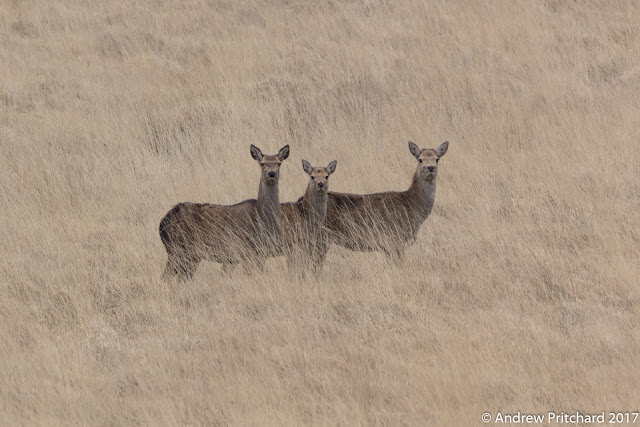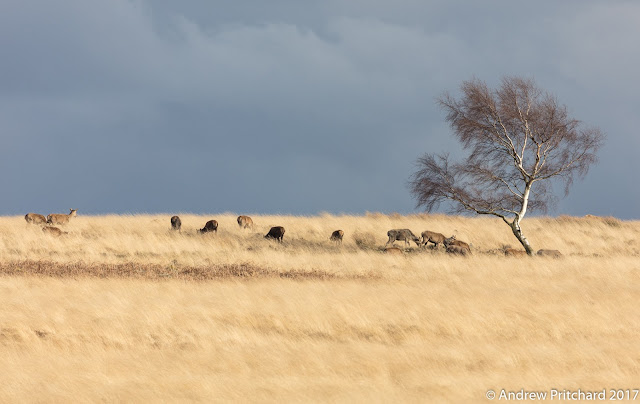March
 |
| Watching the lapwings. |
It is the beginning of March, and Spring is on the way. The lapwings provide moments of distraction for the deer on the grassy moorland as the male birds wheel around close to the ground in their eye catching display flights.
 |
| More interested in grass than lapwings |
Not every deer is interested though, but the male lapwings are not bothered, hoping instead that female lapwings looking on are impressed. The deer may look briefly, wondering what is going on, or if there is a threat, but will soon return to grazing.
 |
| Moving on to new grazing. |
Travelling through the rich straw coloured moorland grass to find new grazing. The grass can grow surprisingly high, forming large clumps making the ground uneven underfoot. The deer will naturally follow each other across the landscape as they make their way through the grass and other flora, creating distinct paths.
 |
| Two hinds and a calf checking for danger. |
A small group of deer stop to look for danger, with two hinds flanking a smaller calf, as if to protect it from any danger nearby. Hinds are very protective of their calves, at least for the first year. It may be a different matter when new born calves arrive the following summer however. The yearlings may find that they suddenly have to start a more independent lifestyle.
 |
| A young stag with short antlers with a group of mixed deer. |
There are still some antlers to be seen, but the stag here is still quite young. Perhaps he is not brave enough yet to leave the herd and travel with the older stags, as they look for quiet grazing and somewhere peaceful to grow their new antlers. The previous year's antlers will be shed soon, but clearly not yet!
 |
| Hinds and calves walk through the grass. |
There are large herds of hinds and youngsters from this and recent years left on the moors. The youngsters on the moor seem to spend time with rest of the herd well beyond their first years, with even some two or three year old males remaining close by. They tend to be much more wary of humans without the large stags around though.
 |
| A large number of deer, but only part of the herd. |
Numbers seem to be increasing across the moor. With no natural predator to control numbers, red deer populations can cause damage to not only crops and gardens but also woodland ecosystems, leading to loss of biodiversity. Whether to cull nor not is a difficult question, but without natural predators the deer herd can also become unhealthy, with weaker or diseased animals surviving where once they would have fallen prey to wolves and other predators.
 |
| A solitary hind assessing danger from the shelter of woodland. |
It is possible to find a solitary deer strolling through the woods. Perhaps at this time of year the pregnant hinds are looking for likely places to give birth in the coming months. Areas with good cover, such as this woodland may be good choices.
 |
| A small group of deer grazing on open moorland. |
Out on the moor they prefer to wander in groups, grazing on grass, heather and other small shrubs. There is safety in numbers, as there are more eyes and ears to scan for danger. Some may be lying down to ruminate or chew their cud, regurgitated from their first stomach, called the rumen, and able to watch the surroundings carefully.
 |
| Two calves exploring away from the herd. |
Some of this years calves appear to be more adventurous, exploring some distance from the main herd. These two may be young males, with a more exploratory nature than those who are staying close to their mothers with the main herd.
 |
| Part of the main herd resting in the dead bracken. |
The other youngsters and their mothers seem to like laying down in bracken, perhaps chewing the grass cud they have been just been grazing on nearby. The moorland can provide green grass, yellow grass, bracken, heather and even bilberries all in close proximity, perfect for a lazy afternoon's grazing and rumination.
 |
| The two adventurers look back to the main herd. |
The two young adventurers may have noticed a change in the behaviour of the main herd, is it time to move on in search of fresh grass? These two are determined to explore, yet are not keen to become separated too far from the herd!
 |
| The deer are standing up from their beds of bracken. |
When the deer decide it is time to move on from their resting places in the remains of last year's bracken, it becomes clear how many were lying down partly or fully hidden. Numbers suddenly seem to increase dramatically when the deer rise.
 |
| Two hinds walking through the yellow moorland grass. |
Looking towards the likely new grazing spot, the deer walk slowly through rich straw coloured moorland grass. On a breezy day the old grass stems wave in the wind, making a gentle hissing sound as the air rushes past.
 |
| A calf and hind moving together across the moor. |
This years calves still want to be close to their mothers, but is mum so keen any more? She may be thinking more about a new arrival, soon to be born. Even carrying a developing calf in the womb may be getting more difficult, leading her to lose patience with last year's offspring.
 |
| Ignoring the nearly year old calf. |
Perhaps it is better to get the cold shoulder and be allowed to remain in the herd or group, rather than be driven off. With plentiful grazing on the moorland, the pressure to reject growing calves may not be so strong as it otherwise could be.
 |
| Three hinds and a calf grazing on grass. |
Hinds can be very observant, carefully checking the surrounding area for any perceived threats, but perhaps some of the young calves have not yet learnt this behaviour! Sometimes it may be more important to keep on grazing, or perhaps the grass just holds more interest for the youngster.
 |
| A pregnant looking hinds checks for danger. |
I wonder what this hind is looking at - there is definitely something of interest over there she thinks, but remains unperturbed. Her belly looks more rounded than normal, indicating that she may be pregnant. She probably has two or three months gestation to go until birth in late May or June.
 |
| A calf sitting quietly on green grass. |
A calf from the current year sits quietly, possibly chewing cud or digesting grass. Perhaps it would be good to get used to a more independent lifestyle. In a month or two many of the hinds will have very vulnerable and dependent new arrivals following them around very closely. There will be little time or even room in a new mother's life for older calves.
 |
| A group of deer grazing next to a solitary birch tree. |
Under a darkening sky a group of deer graze next to a solitary birch tree. In March the grass and bracken yellows and browns dominate the landscape, but soon new growth will turn large areas a bright green.
 |
| A stag with fourteen tines looks to his right. |
The stags are still around on the moor in March, but will soon lose their antlers and go to find a quiet place where they can sit, grazing and ruminating whilst their new antlers begin to grow.
 |
| Two second year brockets with a group of hinds and yearling calves. |
In the meantime, there are still hinds to look after. The main herd may still be in small groups, with two or three year old male deer. These are sometimes known as a brocket (two years old), and a spayad (three years old).
 |
| A large stag with a group of younger deer. |
The white tipped antlers on this stag show that he has been quite active this year. The antler points are worn by either fighting with other stags, or attacking vegetation such as trees or heather. This stag is staring dominantly at the surroundings, still protecting the other deer in the herd. This will change soon when the stags will leave the area to find somewhere secluded to rest and prepare for the rut in the Autumn.
If you would like to see more of the monthly posts from this blog, please subscribe using one of the buttons or links available. You can share this blog using the available buttons. Each blog post will comprise a selection of pictures taken by the author, reflecting red deer activity for the month with some explanatory text.
Comments
Post a Comment